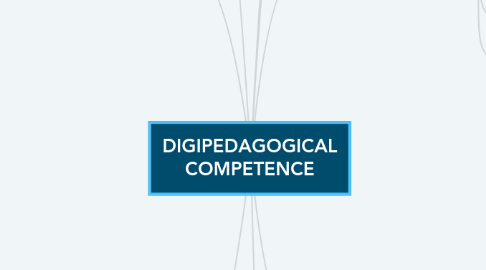
1. Foundation
1.1. ICT
1.1.1. Travnsversal competences Finnish National Core Curriculum
1.1.1.1. "Every Finnish teacher must teach ICT skills"
1.1.2. IN SCHOOLS
1.1.2.1. Operating principles, theoretical concepts and enrichment of competences
1.1.2.2. Responsible and ergonomic use
1.1.2.3. Creative and exploratory use
1.1.2.4. Interact and network
1.1.2.5. DIGITAL NATIVES?
1.1.2.5.1. Teach kids in ICT skills
1.2. TPACK Framwork
1.2.1. INTERPLAY (for meaningful learning)
1.2.1.1. Content Knowledge (CK)
1.2.1.2. Technological Knowledge (TK)
1.2.1.3. Pedagogical Knowledge (PK)
1.2.2. Teachers personal TPACK constantly changing - improving
1.2.3. Technology as a facilitator for learning
2. Broadening perspective
2.1. OECD´s 21st Century Skills
2.1.1. 1. Learning and Innovation skills
2.1.2. 2. Information, Media and Technology skills
2.1.3. 3. Life and Career skills
2.1.4. 4. Core Subjects and 21st Century Themes
2.1.5. IMPORTANT to use technology effectively and meaningfully
2.2. DigCompEdu Framework
2.2.1. European Framework for the Digital Competence of Educators
2.2.2. How digital technologies should be used to improve teaching, learning and training
2.2.3. 1. Professional engagement
2.2.4. 2. Digital resources
2.2.5. 3. Teaching and learning
2.2.6. 4. Assessment
2.2.7. 5. Empowering learnes
2.2.8. 6. Facilitating learners´ digital competence
3. Contexts
3.1. Saville (2012) Context of educational systems and the roles of stake holders in the contexts that affect teaching and learning
3.1.1. MICRO LEVEL
3.1.1.1. Teacher and students
3.1.1.2. Teacher´s personal abilities
3.1.1.3. Teacher´s skills
3.1.1.4. Teacher´s digipedagogical competences
3.1.1.5. Teacher´s experiences
3.1.1.6. Teacher´s attitude
3.1.1.7. How the teacher introduces technology into their teaching
3.1.2. MACRO LEVEL
3.1.2.1. School, community, region and country
3.1.2.2. Societal, municipal and governmental aspects
3.1.2.3. Practicesm beliefs and preferences
3.1.2.4. Regulations, rules and laws
3.2. Online resources for sharing ideas
3.2.1. Freeed.com
3.2.2. TED Ed.
3.2.3. Khan Academy
3.2.4. Linkedln
3.2.5. Facebook groups
4. Key questions
4.1. How do we continue teaching during a pandemic?
4.2. How to improve students digital skiils?
4.3. How to improve teachers self-efficacy regarding ICT?
4.4. Traditional teaching to digital teaching?
4.5. How to create/develop one´s digital identity?
4.6. How to stop technology addiction?
5. Challenges
5.1. Working/studying from home
5.1.1. Difficult to follow students work
5.2. Multiple distractions
5.3. Technology addicton
5.4. Available resources
5.5. Digital strategies into school practice
5.6. Absence of teachers further education
5.7. Inequality between schools and students
5.8. Parents inexperience
5.9. Collaboration between teachers
6. What is it?
6.1. SELF - EFFICACY
6.1.1. What one can do
6.1.2. Willingness to bring ICT into teaching
6.2. Innovative teaching, learning and training
6.2.1. New teaching approaches
6.2.2. Meaningful use of technologies
6.3. Teachers and learners technological skills
6.3.1. Devices
6.3.2. Applications
6.3.3. Softwares
7. By: PILAR GARCÍA, ANDREA GIL AND EVA MORENO
7.1. Early adopters
7.1.1. Experience, skills and methods
7.1.1.1. We use technology in our everyday lifes
7.1.1.2. ICT for studying
7.1.1.3. External studies and self-learning regarding digital competence for teachers
7.1.1.4. We have learned about new digital teaching methods in our universities
7.1.2. Posibilities
7.1.2.1. Online platforms for communication between parenst and teachers
7.1.2.2. Innovative and creative tools inside the clasroom
7.1.2.3. Teaching kids digital skills since a very young age
7.1.3. Threats
7.1.3.1. Hand-writing
7.1.3.2. Social interactions
7.1.3.3. Communication skills
7.1.3.4. Techonological addictions
7.1.3.5. Ciberbullying
7.1.4. Improvements
7.1.4.1. Quality of teaching
7.1.4.2. We still have a lot to learn
7.1.4.3. Keep up with the new digital advances
8. Trends
8.1. Digital natives
8.2. Digitalised world
8.2.1. Globalization
8.2.2. New technology advances everyday

